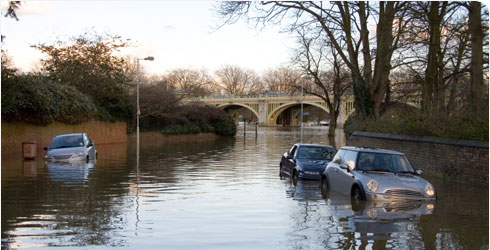Floods
Flood damage to houses and towns is often reported in the newspapers, but what are the long-term consequences of flooding for local wildlife and ecosystems? And is flooding likely to increase as the climate warms?
Floods
What causes floods?
Floods are often caused by extreme weather. Heavy rainfall causes rivers to overflow their banks. The extra water flows on to low lying areas on either side of the river.
Usually floods develop over several days. However, very heavy rainfall over a short period of time can lead to a flash flood with little or no warning.
Flooding in coastal areas occurs when high tides combine with severe storms. One of the worst cases in the UK occurred along the east coast of England in 1953. A large storm surge coincided with a high spring tide resulting in a sea level rise of almost 3m above normal. Over 300 people died, and 24,000 homes were damaged or destroyed.
Floods can also occur when rainwater has nowhere to drain to and collects on the ground. Surface water run-off is one example. Localised flooding occurs when the soil in a particular area is already saturated and cannot absorb any more water, or where drains become blocked or overwhelmed.
What are floodplains and coastal plains?
Floodplains and coastal plains are areas of land adjacent to rivers and coasts that provide natural storage for excess water in times of flood.
Building on floodplains increases the likelihood of floods occurring, because development on this land reduces it ability to soak up water. The Environment Agencies estimate around 2 million properties in the UK are at risk from flooding.
What are the effects of a flood?
Floods can be very dangerous. It only takes 15cm of fast-flowing water to knock a person off their feet. Floodwaters can destroy homes and business, disrupt road, rail and communication links, and ruin crops and agricultural land. Floods also disrupt normal drainage and sewage systems, presenting a serious health hazard from pollution and water-borne diseases.
But floods can also bring benefits. Some of the most fertile land in the world lies beside rivers. Periodic flooding of the Nile and Ganges, for example, carries nutrient-rich silt making agriculture possible.
When was the world’s largest flood?
Some of the largest floods on Earth occurred during the last ice age. They weren’t caused by bad weather but by the failure of natural dams.
For example, in the Pacific northwest United States, during the late Pleistocene, a large ice dam blocked a river forming an immense lake called Glacial Lake Missoula. When the ice dam broke enormous floods ripped through northern Idaho and east Washington.
Similar processes still happen today eg in Siberia and Alaska when ice jams melt and release water each spring.
Can we prevent floods from happening?
Floods are never completely avoidable, but we can try to manage them. This means reducing the likelihood of floods occurring, and minimising their impact.
One way is to build defences such as the Thames Barrier in London. This is a series of movable gates stretching across the river that can be raised if a flood threatens. Other, more natural, defences include using mudflats and salt marshes to provide space for floodwaters to flow into.
In the UK, the Met Office and the Environment Agency use the latest technology to monitor rainfall, and river and sea levels. These can be combined with weather and tidal data to provide local flood forecasts. Warning people that a flood is about to happen gives them time to prepare in advance.
Will climate change mean more floods?
Changes in our climate will increase the risk of flooding due to sea level rises, and potentially more frequent and more severe storms and rainfall events.
Environmental impacts
Floods are natural events and have an important ecological role. However, they can have devastating effects depending on their intensity.
The impacts can be wide-ranging, from destruction of flora and fauna, to damage to agricultural land, and loss of crops and animals.
Immediate impacts
The most serious environmental impact of flooding is the pollution of soil and water.
Flood waters have the potential to spread domestic and industrial chemicals. They can interrupt drainage systems and make sewer systems overflow, causing spills of raw sewage. This contaminates soil and water supplies with hazardous substances.
Impacts on the soil
Soil pollution is a common effect of flooding. Normally flood water carries a heavy load of silts, sediment, debris and gravel that are deposited in the flat areas where the flood water velocity is slower. This deposited material reduces the amount of oxygen in the soil, affecting its fertility.
Also, when floodwater comes into contact with certain chemicals, they form a diluted toxic solution. When the water evaporates, the solution gets more concentrated. This can result in severe contamination of the soil. Some compounds can be absorbed by soil and introduced into the food chain.
However, in some places such as Egypt and Bangladesh, natural river floods are vital for growing crops. These floods bring many benefits to the soil, such as providing nutrients that it would otherwise lack.
Impacts on the vegetation
Floods can tear out plants and trees. A study on the environmental impacts of flash floods on forests in Iran showed that more than 1,500 hectares of forest were destroyed because of heavy flash flooding on 10 and 11 August 2001.
Flooding reduces the supply of oxygen to the soil and roots, slowing the growth of flooded trees. Tree roots are also affected by the concentrated toxic substances that accumulate in flooded soils.
Finally, strong currents and soil particles carried in flood waters can erode soil from around the base of trees, exposing tree roots. Exposed roots are vulnerable to drying and injury. This makes the tree more vulnerable to being uprooted or broken by wind.
A case study: flooding in Romania
In January 2000, flooding caused by a dam failure in Romania had severe impacts on aquatic life in the area. The flood released 100,000 m3 of cyanide-contaminated liquid that was being used to reprocess residue material from a gold deposit. The liquid flowed into the stream of the small river Lapus, and from there into bigger rivers such as the Szamos, the Tisza and the Danube. Hundreds of tonnes of fish were killed.
Almost all aquatic life in the Szamos and upper Tisza Rivers has been wiped out. The long-term effects on the ecological system cannot yet be estimated, but scientists fear that it could take years until the rivers get back to the condition they were in before the disaster, and some of the effects might not be reversible.
Toolbox

There are 27 km of specimen shelves in the Darwin Centre - the same distance as between the Museum and Junction 6 of the M1.
